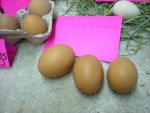I am really surprised that no one here mentioned the "breed" that I think no homesteader should be without a few of (if you want a flock that is likely to survive in difficult circumstance) that is: The Bantam - now I know there are tons of different kinds of bantams, and I discovered this time around looking for chickens that they have "downsized" just about every breed in bantam versions for smaller yards etc; but I am thinking more of the little, usually multi-colored (but sometimes black, gray or brown) hens that go broody at the drop of a hat an mini-roosters that give a whole new meaning to the world "macho."
Now, unless I lived in a city and only wanted a few eggs, I wouldn't want a flock just of banties, but having them around assures you have "natural" incubators (we have one on quail eggs, another on duck eggs, and a third teaming with the Buffy on both Buffy and Bantam eggs on a shared nest - they take over for each other it is very cute).
They also have survival skills (in general) way beyond those of the usual barn yard chicken, our mini-rooster Henry got out a few days ago and managed just fine "being feral" for about a week before we caught him. When the dogs went after him he just flew up onto the roof, when our a chicken the size of a parrot that's easier than if you are the size of Hagrid, my Buffy Rooster (who is a gentle giant).
My hope is to eventually have enough spare bantams around to keep a few in the mixed-run flock and/or a bantam run and also let Henry out with a few girls and just let them circulate about the garden eating bugs and occasionally surprising us with chicks (where we live you do loose chickens this way, but often the bantams can handle it while larger chickens become fox food). We did this a few years ago and one Bantam hen really surprised us (and the barn cats) by hatching about 12 ducks! Sadly the cats got about six of them before we figure out why they were all ringed around one of the bamble bushes, but we did get hen, her ducklings and one baby chick locked up in time to save a few. She had stolen the nest from one of the ducks and we didn't even realize it; this time we are locking the ducks up at night to avoid this fiasco.
But seriously, if you have room and want a "survival flock" be sure to get a few generic bantams, preferably from someone else who already has a flock and has a few extra; that's what we did, a young future farmer of about 16, he picked out the "best layers and mommies" and he was totally correct (at least in terms of sitting eggs, have not had time for a hatching yet).
I'm hoping to keep some of the Buff Orffington hens if we get any from this hatching, but I may also get a couple of rescue battery hens or other hybred layers just for extra eggs. With nearly everyone going broody at once, eggs because an issue - we are building more arcs so we can separate them out and take away the eggs from some of the girls but we are not there yet.
But so far I'm really happy with the Bantie/Buffy combination and I noticed that even Hagrid has no problem with mini-wives, though it looks pretty hilarious watching him "diddle" his tiny hens, it doesn't seem to hurt them any.
(Henry and Hagrid live in separate runs and have different hens to avoid one killing the other, though I'm not sure who would win...).









